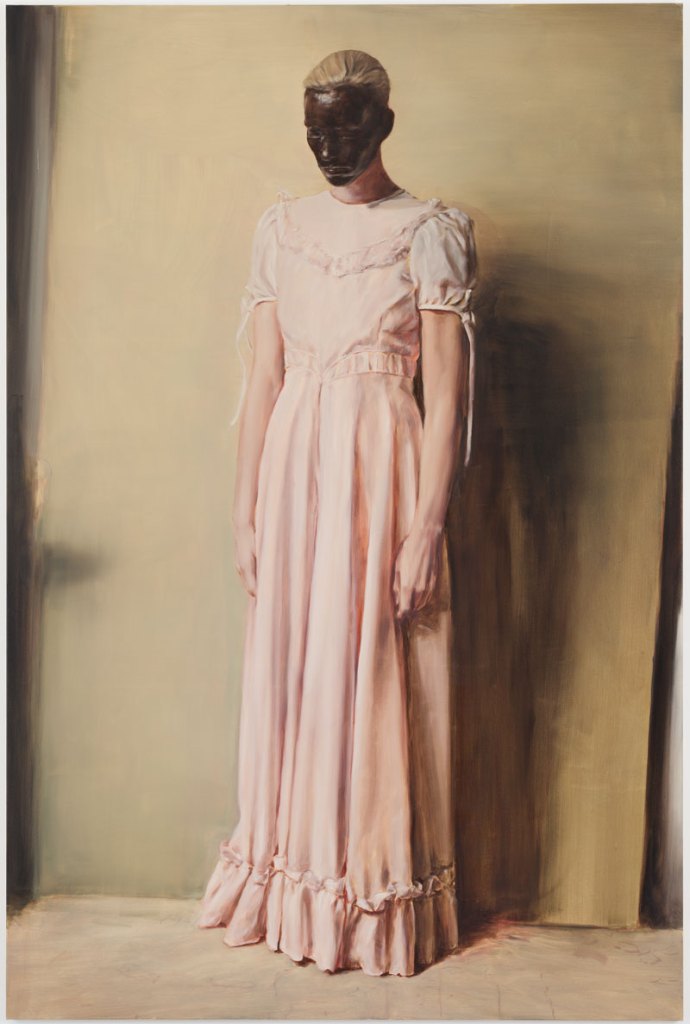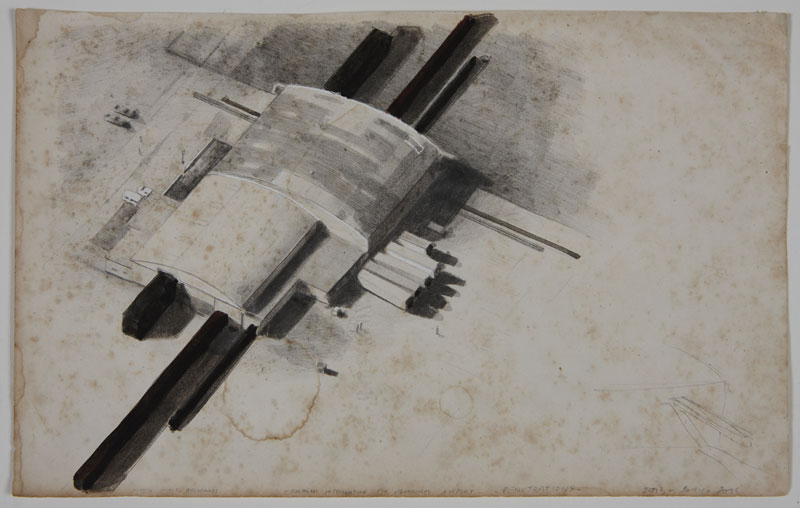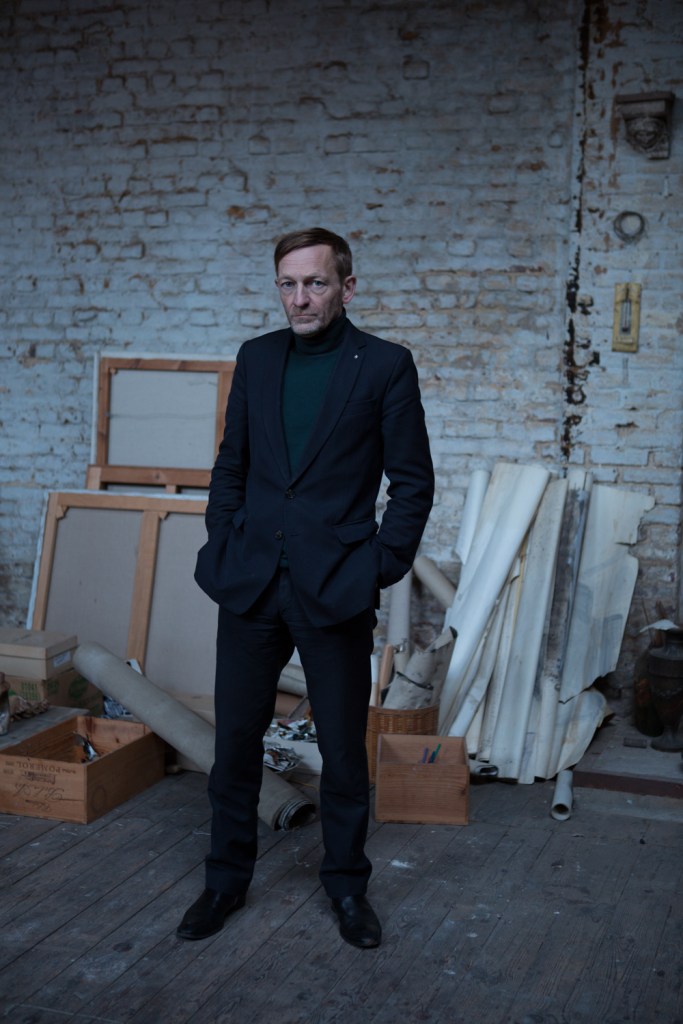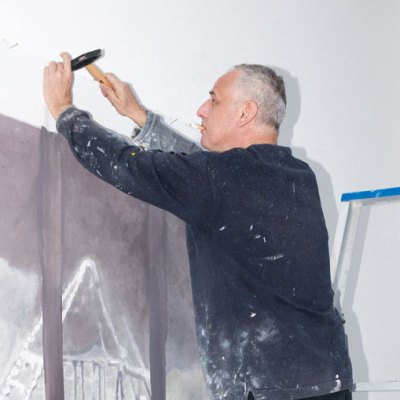‘It has to do with my character, I think, to be charming and irritating at the same time,’ quips Michaël Borremans not long after we sit down in his Ghent studio. ‘I’m very good at that, and it reflects in my work. You cannot place it, you cannot catalogue it, you cannot define it, and otherwise it looks very charming.’ As an interviewee, he is very much on the charming side – sharply dressed, smiling and approachable, despite the fact that, by visiting in daylight hours, I am interrupting his work. He speaks with the friendly guardedness of somebody used to fielding questions they either don’t want to answer, or have no answer for. ‘People always think there is a key!’ he exclaims, as we discuss the attraction and frustration of his art. ‘There is no key.’
That may be true, but Borremans’ success as an artist hinges on our expectation of one. Born in Geraardsbergen, Belgium, in 1963, he trained as a photographer and graphic artist in Ghent, but in the late 1990s he abandoned both, along with a teaching job at the city’s Stedelijk Secundair Kunstinstituut, to master painting. Since then, he has made his name creating exquisite pictures of uncanny figures, who sullenly refuse to explain themselves. What are we to make of the girl with a scuffed face in The Preservation (2001), partially shrouded in what looks to be transparent plastic-wrapping; or the series of truncated Automats he made in 2008–09, which turn away from the viewer like broken Degas dancers? How should we interpret the tall, slender Angel with a pink dress and black painted face, who featured so prominently in his retrospective at BOZAR in 2014; or the sinister hooded figures that followed in his solo show ‘Black Mould’ at David Zwirner last summer? Each of his unnamed characters (Borremans never paints portraits) are so engrossed in their odd rituals, so taken with their props and costumes, that it is very difficult not to follow their lead, and invest them with some kind of special significance.
The Angel (2013), Michaël Borremans Courtesy Zeno X Gallery, Antwerp/David Zwirner, New York, London; © Michaël Borremans

This feeling intensifies inside Borremans’ studio, a refurbished carpenter’s workshop that the artist acquired, semi-derelict, in 1993. Its many large rooms are littered with objects: a taxidermied badger stands guard in the living room; architectural models sprawl on top of plan chests; a group of small sculpted busts, familiar from early drawings, are lined up on a shelf, awaiting the day that they become useful again. The building itself is the epitome of elegant contemporary renovation, but in these details – the ordered clutter and the mute potential of every item – it reminds me of a Dutch genre-painting. Propped up in the corner of one room, I spot a cardboard model of two Belgian bell towers, joined at the base, that I recognise. It features in Borremans’ unnerving painting The Missile (2013), clasped by a shy-looking child in nondescript, ochre-coloured clothes. She handles it with the same delicacy as a donor in a Renaissance altarpiece offering a chapel to God – except, as Borremans’ title would have it, this is a gift of war, not peace. In the painting, the object becomes a frightening, if flimsy, attribute of our technological age, but in the studio, the artist shifts the significance again, likening its shape to a rocket. ‘Maybe this is the future of the Catholic Church,’ he laughs. ‘Building spaceships to look for God!’
This slippery sort of symbolism is the stuff of nightmares for iconographers, but a form of it is at the heart of many of history’s most compelling images – something Borremans recognised early in life. ‘The first artworks I saw were reproductions of Van Eyck,’ he recalls. ‘They were windows on a strange world. As a child they fascinated me but frightened me too – and they still do, in a way.’ Jan van Eyck’s masterpiece (begun by his brother Hubert), the Ghent Altarpiece, is just a short walk away, undergoing restoration in the city’s Museum of Fine Arts; twice during our interview, Borremans urges me to visit. The Flemish artist’s works, which combine the stillness of medieval art with a startling naturalism only possible in oils, are the subject of countless studies, interpreted and reinterpreted seemingly without end. The same can be said of almost all the Old Master painters Borremans most admires: from Velázquez, whose Las Meninas has confounded scholars and artists for centuries; to Manet, stuck in a tussle between Impressionism and tradition; and the ever enigmatic Goya.
The Missile (2013), Michaël Borremans. Courtesy Zeno X Gallery, Antwerp/David Zwirner New York, London; © Michaël Borremans; photo: Peter Cox

In method as much as mood, Borremans owes a lot to the Old Masters, adopting and adapting some time-honoured techniques. For years now he has staged his compositions in the studio, hiring models to bring his props and costumes to life against classically neutral backdrops. Instead of sketching his subjects or painting them from life, he photographs them, and ultimately works from an image on his computer screen – but even this part of the process he credits, at least in its essence, to Vermeer. ‘He used a camera obscura,’ he remarks when I bring up the artist, clearly only mildly interested in my observation about their mutual use of props. ‘He already used photographic tricks in his compositions – things that were only repeated in the 19th century. […] He played with that in a very modern way.’
Today, the impact of photography on painting can be seen everywhere, and Borremans is frequently associated with contemporary artists – Gerhard Richter and Luc Tuymans chief among them – who explicitly reference the medium in their compositions and technique. So it comes as something of a surprise when he goes on to disavow it. ‘I want to step away from what I would call the “terror” of the photographic image in painting,’ he tells me. ‘I like what Mr Richter did – marvellous – but I don’t want the characteristics of a photographic image dominating my work.’ This is part of the thinking behind his use of a monitor, which he keeps at a distance from his canvas: ‘When you place it further [away] you have to find painterly solutions for what you see…you have to guess.’ In The Ear (II) (2011), which depicts the back of a woman’s head and shoulders, Borremans eschews the smooth, photorealistic finish that Richter made famous in 1988 with his comparable composition, Betty, in favour of a more suggestive, gestural approach. ‘If you’re too close to a photograph technically then you make a dull painting – it’s more exciting when you make it risky,’ he says, before bringing it back, yet again, to the Old Masters. ‘That’s what you see in work by Velázquez or Manet: that’s why I’ve learnt so much from them.’
The Ear (II) (2011), Michaël Borremans. Courtesy Zeno X Gallery, Antwerp/David Zwirner New York, London; © Michaël Borremans

It’s only later that the extent of Borremans’ mistrust of contemporary painting becomes clear. ‘Luc [Tuymans] is a great artist,’ he smiles, when his fellow countryman’s name comes up, ‘but we don’t have to be friends.’ Then he throws down the gauntlet. ‘In painting he is one of the few living artists I think are good: I am always ashamed to be a figurative painter.’ That’s a remarkably contrarian thing for one of the world’s most celebrated figurative artists to say, but Borremans’ attitude to the medium does run contrary to today’s apparent norms. He works in an art world that – having seen painting flattened out in the 20th century – now seems intent on picking it apart. In one respect he remains thoroughly of his time: ‘I tend to leave some canvas visible, either by scraping off paint with a knife, or by using transparent paint, or by leaving some canvas open,’ he tells me. ‘I want to make it clear that it’s an illusion.’ But even as he points out painting’s tricks, he treats the medium with a respect that borders on reverence.
In 2012, Borremans acquired a second, ‘secret’ studio in Ghent – a disused chapel that, in a very real way, is still a sanctuary for the artist. It is there that he has created some of his most famous works, including the ominous Angel that, since its completion in 2013, has become something of an icon. ‘For me, it is a figure of transcendence,’ he says eagerly, picking up a postcard of the work from a stack near our table. ‘When I painted it I was in a difficult emotional state…She got me through to a new place. […] It was painted during one week, in the chapel, and it was very intense. I didn’t dare leave the room – I thought if I left before it was finished something bad would happen.’ The oversized figure is an extraordinary creation – magnificent, yet, with her downturned eyes and black masked face (the artist painted the model’s face before taking his photographs), charged with a peculiar contemporary malaise. ‘It helped me in a very personal way, but I could tell it was a work of great universality,’ he recalls. ‘Gender, racism…I wanted to point to all these things. It’s a portrait of humanity in a way.’
Sculptural Installation for Abandoned Airport (penetrations) (2013–15), Michaël Borremans. Courtesy Zeno X Gallery, Antwerp; © Michaël Borremans; photo: Dirk Pauwels

This universality is not something Borremans expects of his drawings. Busier and more complex than his canvases, they act partly as their foil. ‘Drawing…offers me the most freedom, because it’s only pencil and paper and there are no boundaries,’ he explains. ‘You can do whatever you want in a drawing – not in a painting. Not in my case.’ When we meet, a series of his works on paper are on display at Ghent’s contemporary art gallery, S.M.A.K., in the group exhibition ‘The Bottom Line’. Dating from 2011 to 2015 (Borremans frequently returns to ideas long after he first has them) they each depict a ‘sculptural installation for an abandoned airport’, seen from above. ‘I have a tradition of designing ideas for monumental installations that are…realisable in a drawing, but not possible to make in reality,’ he explains. These mysterious buildings and runways ‘can only be seen from the air…you cannot visit. Therefore they become mythical.’ In the studio, he shows me one of the architectural models that he worked from, scattered with dried leaves and tiny figurines. ‘Don’t touch it,’ he instructs me hastily as I approach. He has a mind to stick the whole thing down, ‘and then it would be a work. I like the mystery of it, I like the cheapness of it…But [it] has a lot of meaning for me too.’ I get the impression that, had he the means – and increasingly he does – he would be tempted to make these ‘impossible’ sculptures in real life.
Sculpture is the hidden medium in Borremans’ oeuvre. Physical objects lie at the heart of every piece he makes, and his studio is full of them – from blown-up versions of old props, to complex dioramas, all made by assistants at his request. His fascination with sculpture even led him to pursue film – a paradoxical outcome that he explains as we discuss his second moving-image work, Weight (2005). Inspired by one of his own drawings, Borremans had ‘an idea for a small sculpture, a bit smaller than life-size like in medieval paintings, and turning around’. But when he tried to execute it in three dimensions, something didn’t work. ‘The problem with sculpture is that it’s concrete, it’s in our space,’ he says. ‘And that’s what I like so much about painting – it’s in another space.’ He compromised by making a film, in which the head and torso of a girl (played by a live model) revolves slowly like a living music box, prefiguring his painted Automats. ‘If I make a film,’ he explains, ‘I can direct how the viewer sees it.’ It was a way of wresting back control by reverting to two dimensions, but he still puzzles over the third. ‘Maybe it will be in sculpture,’ he says, when I ask about his next project. ‘But especially in painting I’ve got new paths to follow. I am convinced of that.’ Throughout our conversation, he always comes back, eventually, to the mystery of the canvas.
Black Mould/The Dance (2015), Michaël Borremans. Courtesy Zeno X Gallery, Antwerp/David Zwirner, New York, London; © Michaël Borremans; photo: Dirk Pauwels

Shortly after it was created, Borremans’ monumental Angel became the main publicity image for ‘As Sweet as It Gets’, his retrospective at BOZAR, Brussels, which subsequently toured to Tel Aviv and Dallas. The remarkably successful exhibition proved a high point, and a turning point, in his career. ‘It was very purifying for me,’ he explains. ‘Because I have to tell you, I was so tired of my work! When you have to make a catalogue, and install the same work three times…I knew it was good, but it was time for new challenges.’ One such challenge was ‘Black Mould’, Borremans’ solo show at David Zwirner, which fell between two popular Goya exhibitions at the Courtauld and the National Gallery, and was directly inspired by the Spanish artist. ‘I’ve been looking at Goya a lot…not to copy, just to feel his spirit and let [it] take possession of me,’ he chuckles. The result was a disturbing series depicting figures in the garb of Bunraku puppeteers – though they seem more like puppets themselves – awkwardly performing ritualistic, sexual, and violent acts. In their uncertain context, they could be terrorists, or Ku Klux Klan members, or prisoners at Abu Ghraib – modern Disasters of War. Goya’s spirit even inspired Borremans to return to etching, for the first time in almost 20 years, as a way of developing the series. ‘I picked it up again last year,’ he tells me. ‘I wasn’t bad at etching when I was young…but I’m better now that I’ve become a painter.’
The Preservation (2001), Michaël Borremans. Courtesy Zeno X Gallery, Antwerp/David Zwirner New York, London; © Michaël Borremans; photo: Peter Cox

To me, the foolish, frightening figures in ‘Black Mould’ encapsulate today’s deep-seated fears about religious extremism and I can’t help noticing how frequently Borremans mentions faith. ‘I was raised Roman Catholic, but then I lost my belief,’ he tells me when I ask. ‘I still like the idea that people come together in a building to reminisce about life and death…But every religion that is institutionalised is bad. It should be like Buddhism: only in thoughts. Otherwise it’s about power, and then you miss the point.’ I feel briefly vindicated in my interpretation of his work – it doesn’t last. ‘I mean, there are some references in that direction,’ he owns, ‘but then there are references in other directions too!’
There is no key. But I wonder whether there isn’t one consistent concern, underlying the wavering symbolism of Borremans’ oeuvre – the ritual of art itself. As I leave, he reminds me again to visit the Van Eyck, so I walk a meandering route to the museum, speculating about the whereabouts of Borremans’ chapel studio as I go. Inside the gallery, a group of conservationists work diligently behind a glass screen, engrossed in their scientific efforts to save this mysterious work of art. I am put in mind of Borremans’ strange girl undergoing her own rite in The Preservation, and then of Borremans’ words from earlier that day. ‘I find it fascinating that modern man can still be moved by painting. It’s completely in opposition to our technological evolution, [and yet] somehow man is still more attracted to incomprehensible, strange, funny stuff than to rationalism.
From the March issue of Apollo: preview and subscribe here.
Michaël Borremans in his Ghent studio, January 2016. Photo: Gianluca Tamorri




